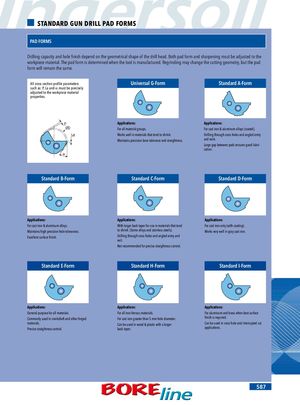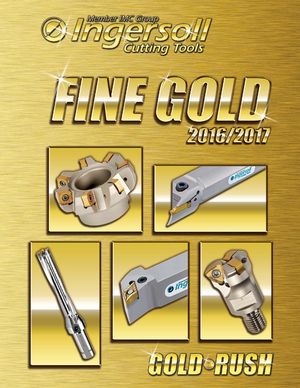Общий каталог Ingersoll 2011 - страница 585
Навигация
- 0003 Table of Contents
- 0006 End Mills
- 0064 Long Edge
- 0104 0Deg Face Mills
- 0160 Face Mills
- 0202 Slotters
- 0218 Form Mills
- 0236 Profile Mills
- 0302 Milling Tech
- 0384 Solid Carbide
- 0448 Solid Carbide Tech
- 0474 Holemaking & Thread Milling
- 0666 Holemaking & Thread Milling Tech
- 0720 Innofit Top On Toolholders
- 0738 HSK Toolholders
- 0774 CAT Toolholders
- 0796 BT Toolholders
- 0816 Adaptions Accessories
- 0872 Turning Inserts
- 1024 Turning Holders
- 1144 Turning Tech
- 1174 Threading Inserts
- 1242 Threading Holders
- 1256 Threading Tech
- 1268 T-Clamp
- 1344 T-Clamp Tech
- 1376 T-CAP
- 1388 T-CAP Tech
- 1394 Product_Index

STANDARD GUN DRILL PAD FORMS PAD FORMS Drilling capacity and hole finish depend on the geometrical shape of the drill head. Both pad form and sharpening must be adjusted to the workpiece material. The pad form is determined when the tool is manufactured. Regrinding may change the cutting geometry, but the pad form will remain the same. All cross section profile parameters Universal G-Form Standard A-Form such as: P, La and a must be precisely adjusted to the workpiece material properties. Applications: Applications: For all material groups. For cast iron & aluminum alloys (coated). Works well in materials that tend to shrink. Drilling through cross holes and angled entry Maintains precision bore tolerance and straightness. and exits. Large gap between pads ensures good lubri- cation. Standard B-Form Standard C-Form Standard D-Form Applications: Applications: Applications: For cast iron & aluminum alloys. With larger back taper for use in materials that tend For cast iron only (with coating). Maintains high precision hole tolerances. to shrink. (Some alloys and stainless steels). Works very well in gray cast iron. Excellent surface finish. Drilling through cross holes and angled entry and exit. Not recommended for precise straightness control. Standard E-Form Standard H-Form Standard I-Form Applications: Applications: Applications: General purpose for all materials. For all non-ferrous materials. For aluminum and brass when best surface Commonly used in crankshaft and other forged For cast iron greater than 5 mm hole diameter. finish is required. materials. Can be used in wood & plastic with a larger Can be used in cross hole and interrupted cut Precise straightness control. back taper. applications. 587
 Общий каталог Ingersoll 2016 - 2017
Общий каталог Ingersoll 2016 - 2017 Общий каталог Ingersoll 2014
Общий каталог Ingersoll 2014 Каталог Ingersoll инструмент для нарезания резьбы
Каталог Ingersoll инструмент для нарезания резьбы Общий каталог Ingersoll 2013 - 2014
Общий каталог Ingersoll 2013 - 2014 Каталог Ingersoll новинки 2021
Каталог Ingersoll новинки 2021